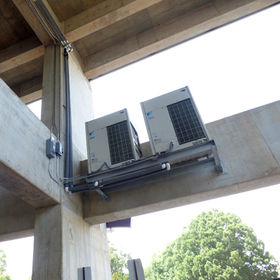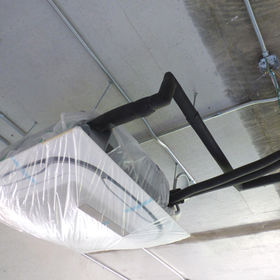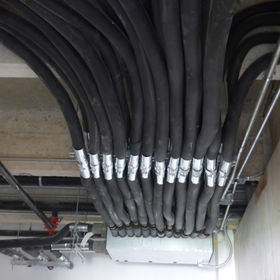By Tim Ledden - Armacell Technical Manager-Insulation
Closed Cell Insulation is an Ideal Solution for Insulating VRV and VRF Systems.
It is estimated that the installation of variable refrigerant volume systems VRV (Variable Refrigerant Volume) or VRF (Variable Refrigerant Flow) in the U.S. may increase by 200% or more over the next five years. So what is their increasing appeal and how do these systems work?
Efficiency
 VRV/VRF systems satisfy the heating and cooling needs of individual spaces by varying the flow of refrigerant to terminal units (evaporators) based on demand. Many larger commercial systems, like the one installed at Clemson University’s Memorial Stadium, also have energy recovery capability, and are able to recover heat from one area and use it in another. An integral heat pump cycle with backup electric resistance heat assures that any additional demand for heat is always met.
VRV/VRF systems satisfy the heating and cooling needs of individual spaces by varying the flow of refrigerant to terminal units (evaporators) based on demand. Many larger commercial systems, like the one installed at Clemson University’s Memorial Stadium, also have energy recovery capability, and are able to recover heat from one area and use it in another. An integral heat pump cycle with backup electric resistance heat assures that any additional demand for heat is always met.
A typical 3-pipe VRV/VRF system has a liquid line, a hot gas line and a suction line from the outdoor unit and each indoor unit branched off from the 3-pipes via a solenoid valve. If there is a call for cooling in one space, the corresponding indoor unit opens its liquid line and suction line valves and acts as an evaporator. An indoor unit requiring heating will open its hot gas and liquid line valves and act as a condenser. These systems can also operate in a mixed heating and cooling mode, redirecting heat from one space to where it is needed in another.
The end result is a supremely energy efficient solution for multi-unit facilities with highly diverse loads.
Flexibility
 This system is ideal when considering space savings. The flexibility of this system allows the elimination of most of the more bulky elements of a typical hydronic system, including chilled water equipment, boilers, large air handlers and ductwork. This system uses small diameter pipe that can easily hide behind walls and above ceilings replacing conventional long runs of clunky ductwork. They are often the typical choice in retrofit situations where the existing infrastructure cannot accommodate traditional HVAC components. In 2015, all the sky boxes at Clemson’s Death Valley Stadium needed a retrofit solution like this which would save space and supply high-efficiency heating and cooling to several connected spaces.
This system is ideal when considering space savings. The flexibility of this system allows the elimination of most of the more bulky elements of a typical hydronic system, including chilled water equipment, boilers, large air handlers and ductwork. This system uses small diameter pipe that can easily hide behind walls and above ceilings replacing conventional long runs of clunky ductwork. They are often the typical choice in retrofit situations where the existing infrastructure cannot accommodate traditional HVAC components. In 2015, all the sky boxes at Clemson’s Death Valley Stadium needed a retrofit solution like this which would save space and supply high-efficiency heating and cooling to several connected spaces.
Specifying the right insulation is particularly critical
In most cases, there are three sets of pipes that require insulating, usually within a very small space or in an exposed area. In either case, the finished installation must be clean, compact and, most importantly, completely sealed to prevent any condensation or frost from forming on the pipe.
Manufacturers are especially selective when it comes to the types of insulation applied to their systems. All VRV/VRF systems use R410A as the refrigerant. The fluid temperatures are much hotter and much colder than those in a hydronic system; therefore, the insulation must be able to accommodate a wide temperature range. Under normal operating conditions, these temperatures range from 3°F to 145°F. Traditionally with HVAC systems, the refrigerant lines are insulated with closed cell, elastomeric insulation.
Can AP Armaflex be used on VRV/VRF systems?
 Many manufacturers of VRV/VRF systems have suggested in their installation manuals that the insulation should be able to withstand upper temperatures of 250°F. To comply with this guideline, installers are unnecessarily limited in product choices for the insulation. It should be noted, however, the normal operating refrigerant temperature will never exceed 150°F. Based on the saturation properties of this refrigerant, the pressure would need to be over 1700 psi to reach 250°F during normal operation of the system. No VRV or VRF system will ever get close to this pressure. In reality, the high pressure side of VRV/VRF systems will operate at about 420 psi and every system has safety controls that will never allow the pressure to get above 600 psi. This corresponds to an operating refrigerant temperature of about 120°F and a maximum refrigerant temperature of about 150°F: both well below the 220°F maximum usage temperature of AP Armaflex® closed cell insulation.
Many manufacturers of VRV/VRF systems have suggested in their installation manuals that the insulation should be able to withstand upper temperatures of 250°F. To comply with this guideline, installers are unnecessarily limited in product choices for the insulation. It should be noted, however, the normal operating refrigerant temperature will never exceed 150°F. Based on the saturation properties of this refrigerant, the pressure would need to be over 1700 psi to reach 250°F during normal operation of the system. No VRV or VRF system will ever get close to this pressure. In reality, the high pressure side of VRV/VRF systems will operate at about 420 psi and every system has safety controls that will never allow the pressure to get above 600 psi. This corresponds to an operating refrigerant temperature of about 120°F and a maximum refrigerant temperature of about 150°F: both well below the 220°F maximum usage temperature of AP Armaflex® closed cell insulation.
Some VRV/VRF manufacturers cite a 250°F requirement for insulation for abnormal temporary situations when there is a problem with the system and repair is required. In this temporary situation, refrigerant may become superheated and reach temperatures up to 250°F before the unit shuts down automatically. The time that the refrigerant temperature would be above the upper use temperature of AP Armaflex would be minimal and likely less than 10 minutes.
AP Armaflex has been tested to ASTM C411, Standard Test Method for Hot-Surface Performance of High-Temperature Thermal Insulation, where it is subjected to 250°F for 96 hours. During this test, AP Armaflex shows no signs of sagging, surface cracking, warping, or delamination and the insulation remained flexible and easy to handle.
Conclusion
ASTM C411 shows that AP Armaflex can withstand the short time periods when refrigerant temperature could be above 220°F due to faulty system operation. Therefore, engineers and contractors can be assured that AP Armaflex can be used safely on VRV and VRF refrigerant lines.
Click here to learn more about the Clemson University Job Story.
